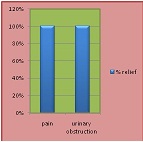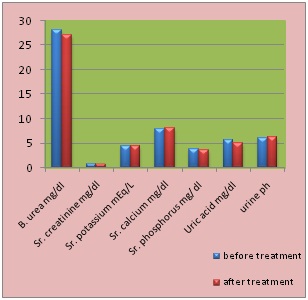A case report of urolithiasis of patient with bilateral ureteric stones
Richa Sharma* *P.G. Scholar, Department of Shalya Tantra, Rishikul Govt. P.G. Ayurvedic College & Hospital, Haridwar, U.K., India Present Address : Richa Sharma, H.N.-605, MIG, Avas Vikas-1, D.M. Colony Road, Bulandshahr, U.P., INDIA, Pin-203001 Mobile No.: 09457063014, Email: richasharmaskd@gmail.com ABSTRACT Urolithiasis is one of the commonest disease of urinary system and a biggest challenge faced by urologists. In Ayurveda, urolithiasis is described as Ashmari & Acharya Sushruta has included it among the Asta Mahagada. In modern era, the medical treatment of urolithiasis is ineffective and lithotripsy or surgical techniques are invasive, costly and related with complications. Many Ayurvedic drugs have been employed to treat urinary stones. The rationale behind use of many of them is not well established. Therefore present study was inclined towards the disintegration and expulsion of stone along with relief in sign and symptoms of urolithiasis by Ayurvedic drug. A case report of a 58-years male, came at OPD of Shalya Tantra Department of Rishikul Govt. P.G. Ayurvedic College & Hospital, Haridwar, has been presented here having bilateral ureteric stones. He was complaining of continuous bilateral pain from loin to groin with mild urinary obstruction since 10 days. His USG report suggested a ureteric calculi of 12 mm size in Lt. ureter [Upper part] and a calculus of 10 mm. size in Rt. Ureter [Lower part]. He was treated with single drug therapy of ‘Kulattha kwath’ with 'Anupaan of Sharpunkha' [Tephrosia purpurea] and 'Sendha namak' [Rock salt] for three months. 100% relief in pain and urinary obstruction with complete expulsion of both ureteric stones was observed and no side effect seen. Variations in all haematological, biochemical, urine routine and microscopic values were observed within normal range. Key Words : Urolithiasis, Ashmari, Ayurveda, Asta Mahagada, Kulattha kwath INTRODUCTION Urolithiasis is known to mankind since time immemorial. In ancient centuries urolithiasis was often a disastrous disease, with a catastrophic outcome all too often leading to the patient’s death. Even today, urolithiasis is the one of the most common affliction of the urinary tract. Detailed medical literature on urolithiasis is available from ancient India. Acharya Sushruta first reported in his text 'Sushruta-samhita' about stone removal techniques1. Thus urolithiasis is a special contribution of Acharya Sushruta. The roots of modern science and philosophy go back to the Ancient Egyptians. In 1901, the English archaeologist E. Smith found a bladder stone from a 4500–5000-year-old Mummy in El Amrah, Egypt. Treatments for stones were mentioned in ancient Egyptian medical writings from 1500 BC2. Since this disease is grievous, so Acharya Sushruta has described it as Daarun (dangerous) disease & included it among Asta Mahagada3. The epidemiology of urolithiasis differs according to geographical area in term of prevalence, incidence, age and sex distribution. Such differences have been explained in terms of race, diet and climate factors4. The overall probability of forming stones differ in various parts of the world and is estimated as 1-5% in Asia, 5-9% in Europe, 13% in North America and the recurrence rate of renal stones is about 75% in 20 years span5. It typically occurs in middle life during the most productive years (30-50years)6 with a male to female ratio of 2:1. Causes responsible for renal stone formation may include hyper excretion of relatively insoluble urinary constituents like oxalate, calcium etc. or may be due to inadequate urinary drainage, renal infections, prolonged immobilisation, decrease in urinary citrate levels, deficiency of vitamin A7 etc. Since its etiological factors & pathogenesis is yet not very clear, so its management is also very onerous. The problem of stone formation is considered as a medical challenge due to its multifactorial etiology and high rate of recurrence. According to Acharya Sushruta either vaatyukta kapha, pittayukta kapha or only kapha get aggravated in the persons who do not undergo shodhana procedures regularly and use unwholesome diet. It then enters into basti, mixes with mutra and takes the shape of an ashmari8. According to Acharya Charaka, shukra, pitta and vaata mix mutra is dried up by action of vaat and then converted into ashmari9. Pain is the leading symptom in 75% of renal stone patients. In the kidney, fixed renal pain (flank pain) is common while in ureteric colic agonising pain is present, passing from the loin to groin10. The stones below 5 mm size flush out spontaneously by the urinary tract. But the stones above 5 mm requires medical management otherwise it can lead to complications like obstruction, severe pain, dysuria, haematuria etc. In modern, the medical treatment of urolithiasis is ineffective and lithotripsy or surgical techniques are invasive, costly, and related with complications. Even modern treatment is also not sufficient to stop recurrence of urolithiasis. Many Ayurvedic drugs in the form of Tab., Kwath, Powder, etc., have been employed since ages to treat urinary stones. The rationale behind their use is not well established through systematic and pharmacological studies, except for some drugs. Therefore, ‘Kulattha kwath’ with ‘Anupaan of Sharpunkha (Tephrosia purpurea) and Sendha namak (Rock salt)11’ were selected for the present study. METHODOLOGY A 58 years old male patient of urolithiasis, having complaint of continuous bilateral pain from loin to groin with mild urinary obstruction since 10 days, was selected at OPD of Shalya Tantra Department of Rishikul Govt. P.G. Ayurvedic College & Hospital, Haridwar on 10-01-2015. After taking informed consent from the patient, the detailed history of patient was taken, in which neither history of any past medical, surgical treatment nor any positive family history of urolithiasis was found. Drug therapy of ‘Kulattha kwath’ was advised with ‘Anupaan of Tephrosia purpurea and Rock salt’ which could be given on O.P.D. basis without requiring hospitalization. General Examination Weight-68 Kg, B.P.-120/ 78 mmHg, P.R.-74/ min, R.R.-18/min, Temp.-97.8 F. Pallor, icterus, cyanosis, pedal edema, lymphadenopathy were absent. Systemic Examination Examination of Respiratory system, Cardiovascular system, Central nervous system and Gastrointestinal system revealed not any defect. Investigations He was advised for USG whole abdomen (KUB Region). His USG report dated 11-01-2015 suggested Biochemical values, haematological values, urine routine & microscopic examinations- Blood urea- 28mg/dl , serum creatinine- 0.8 mg/dl, Sr. calcium-8.0 mg/dl, serum phosphorus-3.8mg/dl, serum potassium-4.4 mEq/L, Uric acid- 5.6 mg/dl, urine ph- 6.0. Other routine blood investigations were also found within normal limits. Ayurvedic treatment (11-01-2015) This treatment was given for a period of 3 months. All ayurvedic classics, modern literature and contemporary texts about the disease and treatment were reviewed and documented for the present study. RESULT- After 3 months treatment- Figure 1: Effect of therapy on clinical sign and symptoms Figure 2: Effect of therapy on biochemical values, haematological values and urine pH USG whole abdomen (KUB Region) findings dated 15-04-2015 on completion of treatment DISCUSSION So, in the present case study, pain might be relieved due to Shothhara property of Kashaya rasa and Ruksa guna of Kulattha, Urinary obstruction might be relieved due to Saarak property of Amla vipaka of Kulattha. ‘Kulattha Kwath' make it easy to expel out the stone due to- Probable mode of action of drug ‘Kulattha Kwath’ – Therapy contains decoction of Kulattha (Dolichos biflorus). Kulattha is having Ashmari bhedana (lithotriptic) property due to Prabhava, Saarak (expulsive) property due to Amla vipaka, Sothhara (anti-inflammatory) property due to Kashaya rasa and Ruksha guna. Krimighna (antimicrobial) property is due to Prabhava. Shoshan of kapha is due to Kashaya rasa, Laghu guna, Ruksh guna. Kapha vaat nashak property is due to Ushna virya12 . Kulattha maintains balance between inhibitors & promoters of crystallization in urine13. It contains Dolichos biflorus Antilithiatic Protein [DAP] which prevent adhesion of calcium oxalate & calcium phosphate crystals on renal parenchyma. Kulattha also contains antimicrobial compound lectin14 and antioxidant pentacyclic triterpenes (betulin, lupeol)15 which prevent further stone formation. Anupaan of ‘Kulattha kwath’ include Sharpunkha (Tephrosia purpurea) & Sendha namak (Rock salt). Tephrosia purpurea is mutral (diuretic)16 and sendha namak balances the vitiated doshas.17 CONCLUSION ‘Kulattha kwath’ with ‘Anupaan of Sharpunkha (Tephrosia purpurea) and Sendha namak(Rock salt)’produced 100% relief in pain and urinary obstruction with complete expulsion of both ureteric stones at the end of three months of ayurvedic treatment. Variations in all haematological, biochemical, urine routine and microscopic values were also observed within normal range and no side effect observed during the study period. So, here it can be concluded that ‘Kulattha kwath’ with ‘Anupaan of Sharpunkha (Tephrosia purpurea) and Sendha namak (Rock salt)’ could be a good treatment to relieve sign and symptoms of urolithiasis and have efficacy to expel stone. It is not only cost effective but also easy to use, hence it can be used as an alternative approach for management of urolithiasis. ACKNOWLEDGEMENT I would like to thank all the faculty members of P.G. department of Shalya Tantra, Rishikul Govt. P.G. Ayurvedic College & Hospital, Haridwar, U.K., India for providing necessary facilities and support for present case study. I am also thankful to the editor and review committee of I.J.W. for providing constructive comments that enabled me to improve the manuscript. DECLARATIONS Funding: None Conflict of interest: None declared Ethical approval: Not required REFERENCES


2. Ahmet T, Fatin C. The History of Urinary Stones: In Parallel with Civilization. The Scientific World Journal vol. 2013, Article ID 423964, 5 pages, 2013. doi:10.1155/2013/ 423964
3. Shastri A. Sushruta samhita with Ayurved tatva Sandipika Hindi commentary –volume1, chikitsasthaan- ashmarichikitsa. 2nded. Varanasi. Chaukhambha Sanskrit Sansthan Publisher; 2012. p .52
4. Trinchieri Alberto. Epidemiology of urolithiasis: an update .Clin Cases Miner Bone Metab. 2008 May-Aug; 5(2): 101–106.
5. Sandhya et al. Kidney stone disease: etiology and evaluation. International Journal of Applied Biology and Pharmaceutical Technology 2010 May-July 1:175-182.
6. Bailey & Love. Short practice of surgery. In: Russell RCG, Williams NS, Bulstrode CJK editors. The kidneys and ureters. 24th Ed. London. Oxford University press; 2004. p.1317.
7. Bailey & Love. Short practice of surgery. In: Russell RCG, Williams NS, Bulstrode CJK editors. The kidneys and ureters. 24th Ed. London. Oxford University press; 2004. p.1322.
8. Shastri A. Sushruta samhita with Ayurved tatva Sandipika Hindi commentary –volume1, chikitsasthaan- ashmarichikitsa. 2nded. Varanasi. Chaukhambha Sanskrit Sansthan Publisher; 2012. p .311
9. Chaturvedi G, Shastri K. Charak samhita of Agnivesh with vidyotini Hindi commentary-volume2, Sastri R, Upadhyaya Y, Pandeya GS, Gupta B editors. Chikitsasthan Trimarmiyachikitsitamadhyay. 2nd ed. Varanasi: Chaukhambha Bharati Academy publisher; 2009. p.726-731.
10. Das. S. A Concise Textbook of surgery, The kidney and Ureter. 8th ed. Kolkata .Das S. publishers, 2014. p.1208-1221.
11. Shah NC. Bharat Bhaisajya Ratnakar-volume1. Kakaradi kashay prakran, 3rd ed., New Delhi: Jain B Publishers; 2012. p.208
12. Sharma PV. Dravyaguna Vijnana- volume2. Mutraladi varga, 2nd ed. Varanasi: Chaukhambha Bharati Academy Publisher; 2006. p. 655.
13. Pareta SK, Patra KC, Mazumder PM, Sasmal D. Establishing the principle of herbal therapy for antiurolithiatic activity : A Review. Journal of Pharmacology and Toxicology. 2011;6(3) 321-332
14. Aphichart Karnchanatat. Antimicrobial activity of lectins from Antimicrobial Activity of Lectins from Plants: Antimicrobial Agents. Bobbarala V editor. 2012. Available at http://www.intechopen.com/books/antimicrobial-agents/antimicrobial-activity-of-lectins-from-antimicrobial-activity-of-lectins-from-plants
15. Yadav et al. Herbal plants used in the treatment of urolithiasis : A Review. IJPSR. 2011;2(6): 1412-1420.
16. Sharma PV. Dravyaguna Vijnana-volume2 .Arshoghnadi varga, 2nded. Varanasi: Chaukhambha Bharati Academy Publisher; 2006. p. 555.
17. Chaturvedi G, Shastri K. Charak samhita of Agnivesh with vidyotini Hindi commentary-volume2, Sastri R, Upadhyaya Y, Pandeya GS, Gupta B editors. Chikitsasthan Trimarmiyachikitsitamadhyay. 2nd ed. Varanasi: Chaukhambha Bharati Academy publisher; 2009. p.56.



